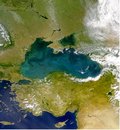Page path:
- Press Office
- Press releases 2007
- Nitrogen Cycling in the Black Sea
Nitrogen Cycling in the Black Sea
In the April 2007 issue of the Proceedings of the National Academy of Sciences of the USA, Max Planck Institute researchers, together with colleagues from Denmark and Switzerland, detected the co-occurrence of aerobic and anaerobic ammonium oxidation in the suboxic water column of the Black Sea (Fig. 1), using a combination of molecular ecological and chemical techniques. The nitrogen gas (N2) thus produced cannot be used as a nutrient for most organisms anymore, and so is considered lost from the system. The coupling between these two aerobic and anaerobic processes implies an enhanced nitrogen loss coming from the recycling of organic matter - which considerably changed our view on how the marine nitrogen cycle really works.
Nitrogen is the building block of all life. It is essential to the making of our proteins and nucleic acids. However, only certain forms of nitrogen is usable for life, that their availabilities often hold the key to ocean productivity. One form of nitrogen is converted to another almost exclusively by different specialized microbes in the marine environment. When a gas is formed (e.g. N2, N2O and NO), very few microbes succeed in using them afterwards.
Nitrification, the stepwise oxidation of ammonium (NH4+) to nitrite (NO2¯) and then nitrate (NO3¯), plays a key role in the marine nitrogen cycle, because it links the recycling of organic matter to the ultimate nitrogen loss from the system (Fig. 2). It occurs exclusively in oxic conditions in conventional view. For decades, only some groups of bacteria have been known to carry out this process. About two years ago, some crenarchaea (a group of microbes that are considered as Archaea instead of Bacteria) were shown to have this capability in the laboratory, and some were found to carry the genetic potential (ammonia monooxygenase gene subunit A, amoA) in the environment. As crenarchaea comprise about 30% of oceanic picoplankton, they are speculated to be the more prolific marine nitrifiers than bacterial nitrifiers. But it is until now in this Black Sea study, that this genetic potential is finally realized in the marine environment via gene expression analyses. Active crenarchaeal amoA expression was the highest in the lower oxic zone, coinciding with the maximum nitrification rates.
A few years ago, part of the same team discovered that the process anaerobic ammonium oxidation (Anammox), instead of denitrification (NO3¯ -> NO2¯-> NO -> N2O -> N2), is responsible for the nitrogen loss in the Black Sea suboxic zone (oxygen is below detection, but before sulphide can be measured). In anammox, NH4+ is combined with nitrite NO2¯ to form nitrogen gas (N2), but the source of NO2¯ has often been suggested to be nitrate reduction (NO3¯ -> NO2¯), part of the previously known denitrification. However, authors of this paper detected, with stable isotope pairing nitrification exactly at the same place as the occurrence of anammox, which is further backed up by functional gene expression analyses, as well as flux calculations. This time in the suboxic zone, nonetheless, it was the bacterial nitrifiers that were responsible for the production of NO2¯, which was directly taken up by anammox bacteria to yield N2.
Contact:
Dr. Phyllis Lam
Phone:+49 421 2028 - 644
Fax:+49 421 2028 - 690
E-mail: [Bitte aktivieren Sie Javascript]
Dr. Marcel M. M. Kuypers
Phone: +49 421 2028 - 647
Fax:+49 421 2028 - 690
E-mail: [Bitte aktivieren Sie Javascript]
Press Officer
Dr. Manfred Schlösser
Phone: +49 421 2028 - 704
Fax:+49 421 2028 - 790
E-mail: [Bitte aktivieren Sie Javascript]
Figure 1. The Black Sea as viewed from above. – The Black Sea is the largest stratified basin the world, with an oxic layer sitting above an anoxic layer, and the strong stratification prevents the export of nutrients from the deep to the surface layer. The turquoise swirls are due to blooming coccolithophores, which could flourish as they can utilize regenerated nutrients. Diatoms and dinoflagellates (in green) could only grow at the river mouths along the coasts (Credit: provided by the SeaWiFS Project, NASA/Goddard Space Flight Center, and ORBIMAGE)
Fig. 2. A simplified marine nitrogen cycle.


